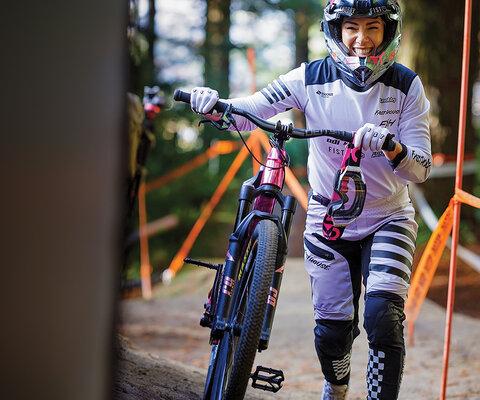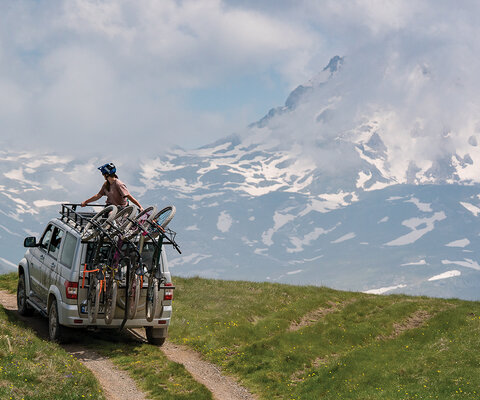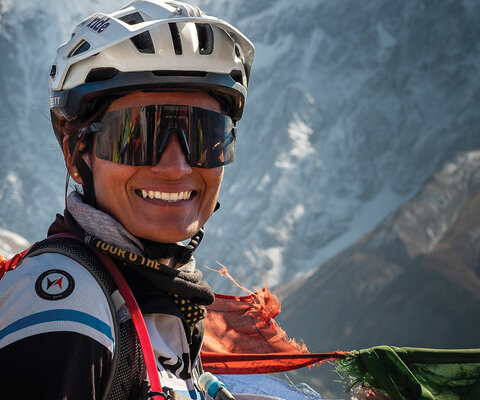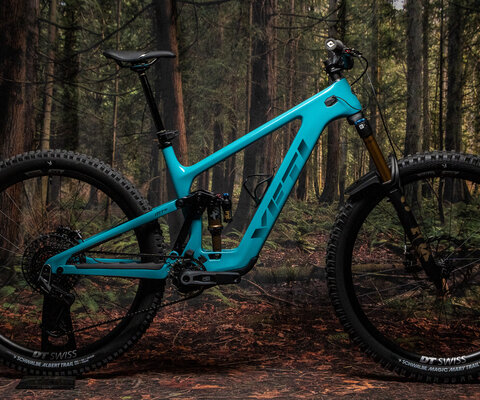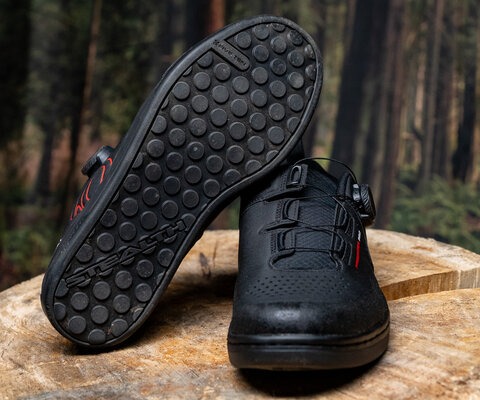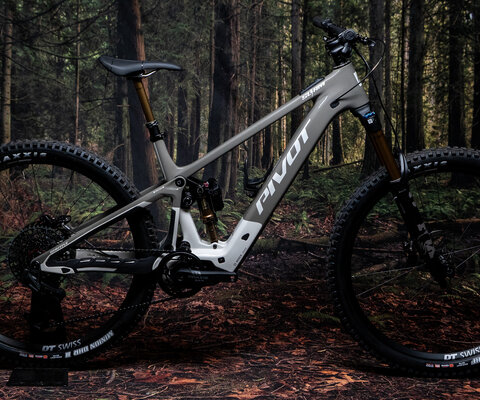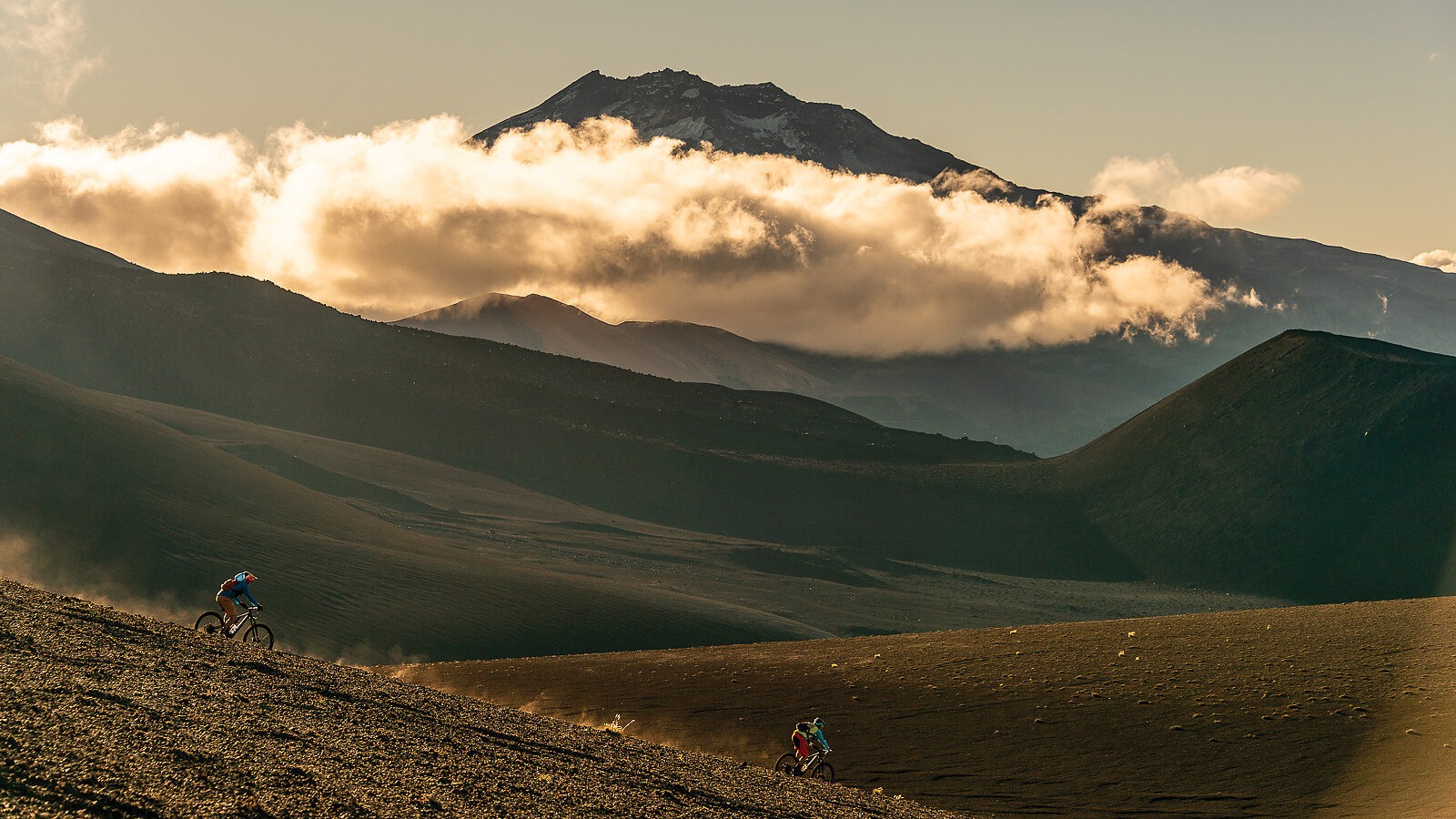
Monkey Puzzle The Missing Pieces of Central Chile’s Volcanic Hinterlands
Words by Andrew Findlay | Photos by Kari Medig
The laws of physics are immutable. In Newtonian mechanics, momentum is the product of an object’s mass and velocity. This could explain why Victor Abarzua—a man who is 6 feet, 5 inches tall and weighs 244 pounds—nearly leaves Ernesto “Máquina” Araneda in a puff of volcanic ash after straight-lining a 30-degree cinder cone on Volcán Batea Mahuida, a plateau-shaped volcano that straddles the border between Chile and Argentina.
When he was only 14, “Máquina” (Machine) was already a Chilean national mountain biking champion and went on to be a Pan-American Games bronze medalist and a World Cup Masters silver medalist. Now, he has young kids and works as a full-time guide, occasionally squeaking in an epic race when he can find the time.
Araneda has been quietly toying with me and Canadian photographer Kari Medig ever since we landed in his hometown of Temuco, a city located some 400 miles to the south of the Chilean capital, Santiago. We’d set off to explore a microcosm of frontier mountain biking in this land of lakes and volcanos, a place that seems naturally forged for vertical pursuits.
And here we are, ripping down an extinct volcano and trying to cling to the back tire of Abarzua—a former professional Chilean basketball player—as he carves high-velocity flow on a mix of sculpted singletrack and repurposed animal trails. For such a big man, Abarzua is remarkably agile. The descent culminates into a flock of noisy chickens free-ranging around a hamlet of wood-framed houses with tin roofs. It’s the village of Icalma, a community of mostly indigenous Pehuenche mountain people. Three men watch as we ride up, as though they’re expecting us. Turns out, they are expecting us.
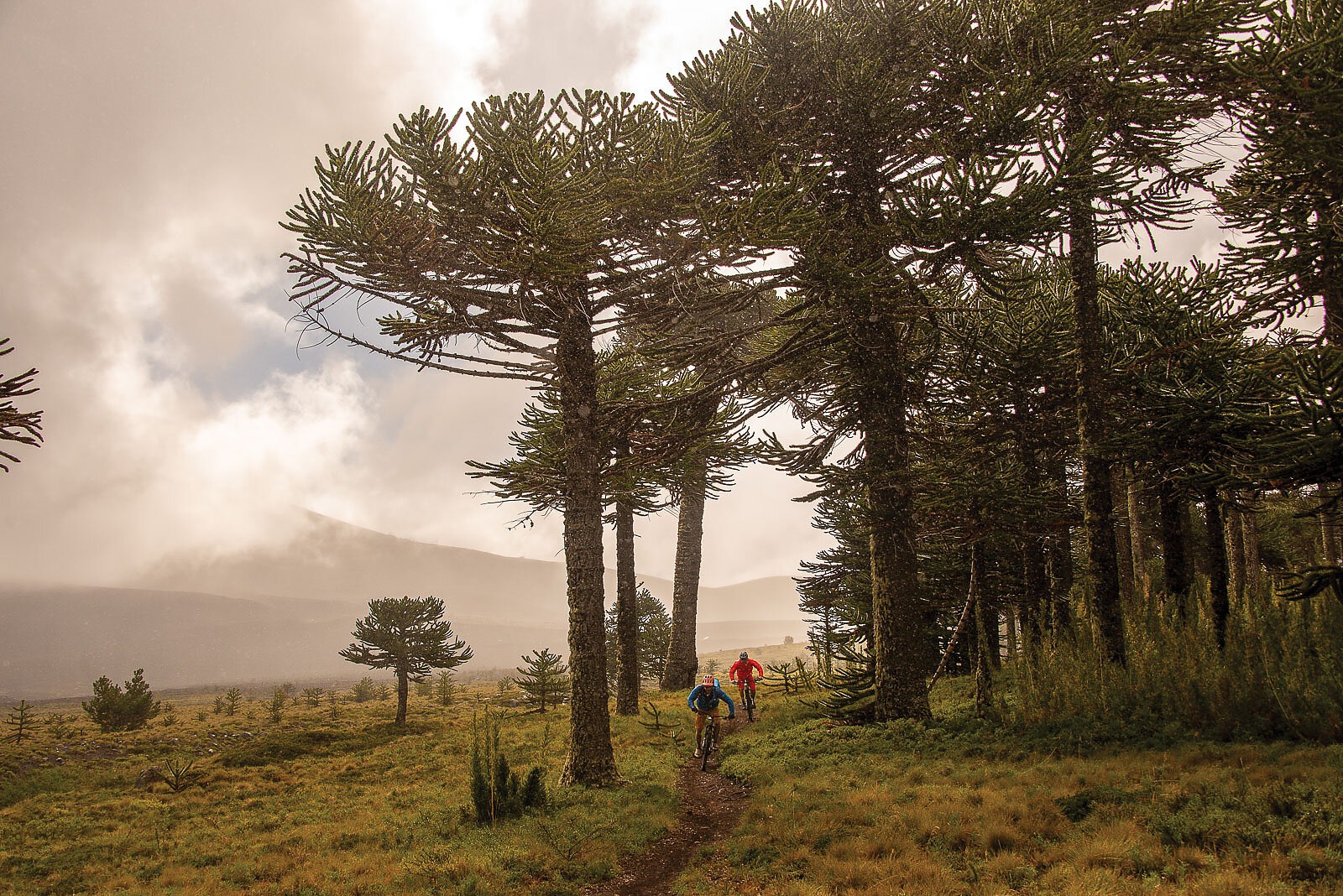
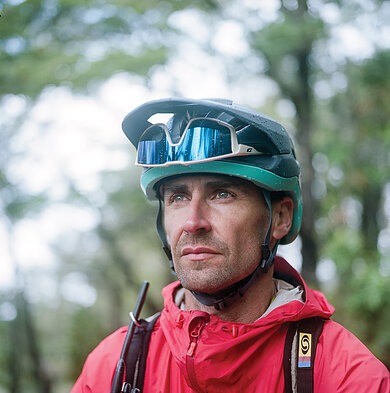
Abarzua dismounts and gathers an ancient-looking Pehuenche man in a massive, bear-hug embrace. The old fella all but disappears into Abarzua’s bike jersey before reemerging, leaning heavily on a wooden staff. His sparkling eyes are set deeply in a tanned face as wrinkled as a dried apple.
“Nobody knows exactly how old he is, but they say at least 100,” Abarzua had told us moments ago, as though we’d stumbled upon a Chilean blue zone.
Six years ago, Abarzua settled on a chunk of land his father owns in Icalma and opened a guest lodge with the hope of growing a mountain biking culture out of nothing other than the necessary raw ingredients of vertical relief. It’s clear that Abarzua feels at home here, and there’s a familial warmth between the two men. They chat about local politics, the weather, and how it’s been a bad year for the fleshy nuts, or piñones, that are produced by the distinctive native conifer known widely as the monkey puzzle tree. Also known as the piñonero or Chilean pine, Chile’s national tree produces an abundance of these nuts, which are a local staple eaten in huge quantities by the Pehuenche (which means “people of the pehuén tree” in the region’s indigenous language).
“Le gusta,” says the youngest of the three men as he passes around a bowl of piñones.
Abarzua discreetly hands a small wad of pesos to the old man. If it weren’t for the smiles and laughter, this transaction could be mistaken for something nefarious. It’s anything but. Strong relationships take time to build, and in the Pehuenche territory of central and southern Chile, life is all about relationships— especially when it comes to building mountain bike trails through forests of majestic monkey puzzle trees.

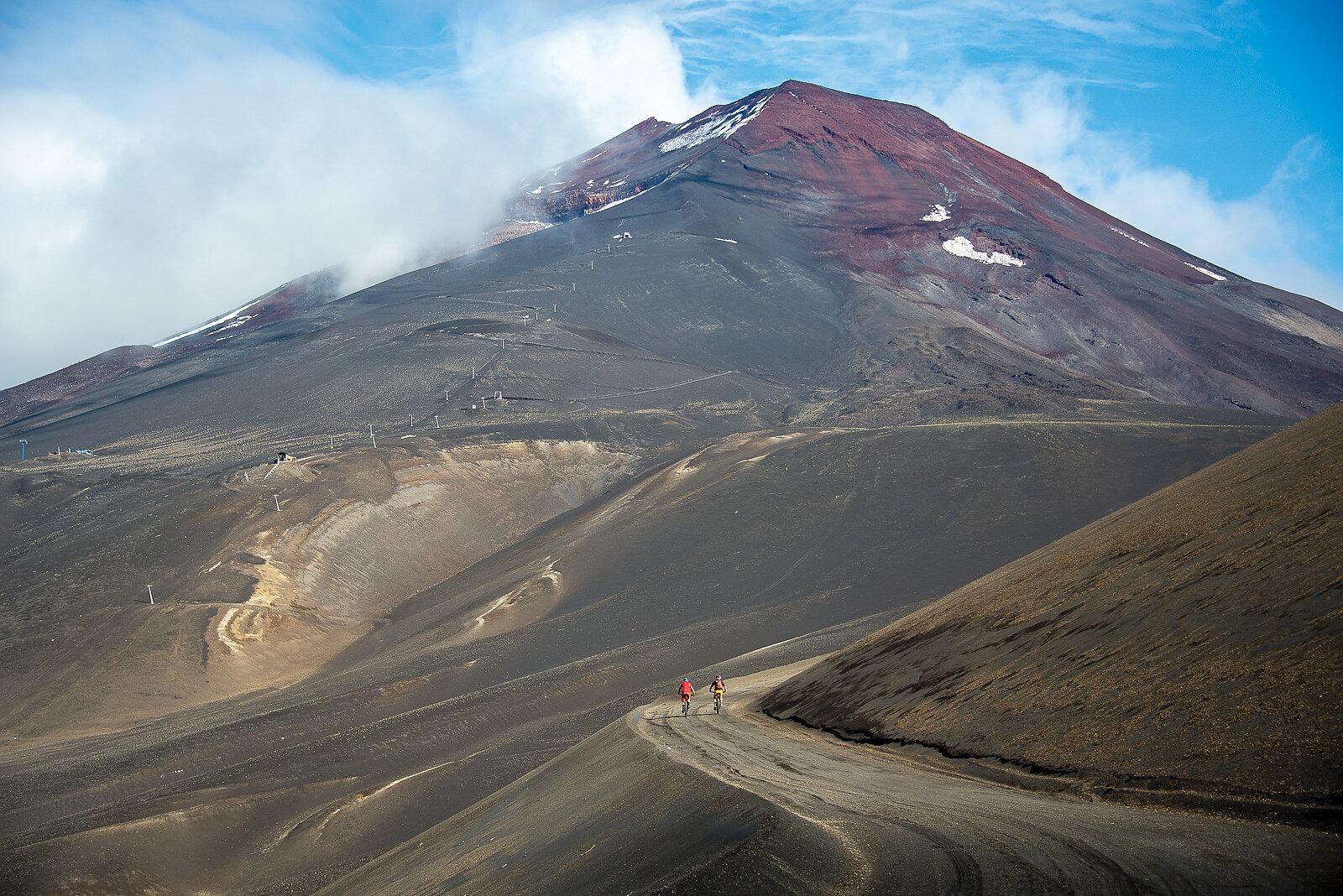
After 10 more minutes of chit-chat, Abarzua hugs our centenarian host, and we all climb back into his pickup for another lap.
“When I asked the local Pehuenche if we could access their land for mountain biking, they said, ‘Sure, but why? Bikes are for transportation,’” Abarzua explains with a laugh as he recalls this cross-cultural confusion.
However, a seed had been planted. If the Pehuenche didn’t understand the point of biking for fun, they certainly liked the business side of Abarzua’s proposal: That he would pay them a small fee to access trails on their ancestral land, at the same time providing an opportunity for them to sell snacks, tortillas, and refreshments to visiting mountain bikers. He was inviting them to participate in a fledgling tourism economy, but it was not just an economic prospect. It was a community-bonding experience.
Abarzua zips along Icalma’s main street, dodging potholes before eventually stopping in front of a gated house. An iron enclosure swings open, and a young Pehuenche man named Aldo Torres Nahuelcura hops into the crew cab. Nahuelcura, who flashes us a big, easy smile, has volunteered to be our afternoon driver. He’s excited to show us one of the most recent builds—a trail called “We Nu Mapu,” which means “the land above” in his native tongue. After 15 minutes of bumpy dirt road shuttling, we’re in the land above.
“WHEN I ASKED THE LOCAL PEHUENCHE IF WE COULD ACCESS THEIR LAND FOR MOUNTAIN BIKING, THEY SAID, 'SURE, BUT WHY? BIKES ARE FOR TRANSPORTATION.’”
—Victor Abarzua
“I’ve been working on this trail for about two years,” Nahuelcura says. “Make sure you ride the log.”
As usual, Abarzua leads the charge, with his lean and lanky buddy Araneda coasting in the rear. The reddish dirt is perfect, tacky from an overnight deluge. The trail winds through stout, old-growth monkey puzzle trees, weaving dangerously close to low-sweeping branches with razor-sharp, skin-shredding leaves. Rounding a blind corner, we startle a trio of Pehuenche who are using slingshots to harvest clusters of piñones. They scatter to the side of the trail.
“Hola amigos!” Abarzua shouts without squeezing his brake levers.
Ahead of us lies the aforementioned “log,” a wind-fallen monkey puzzle tree with a stout trunk that is tailor-made for an elevated trail feature six feet off the ground. It’s the only contrived stunt on a trail that is otherwise raw and scrappy, winding through the high-elevation forest before becoming steep and techy as we descend to the valley bottom.




Two days of singletrack bliss around Icalma pass in a blink, and now we’re munching yet more piñones at a roadside stop between the villages of Lonquimay and Malalcahuello. In the local dialect, Lonquimay means “headless”—presumably a reference to the fact that many caps of the towering volcanos that dot the landscape have been blown. This rugged region of Chile is one of the world’s most seismically and volcanically active places, and the terrain feels temporary, as though it could be transformed in an instant.
It has been in the past, and it will be again. Geologic history is recorded in the layers of ash that line the river-cut banks. The massive Volcán Lonquimay last erupted violently on Christmas Day in 1988, with the initial blast shattering windows in nearby Malalcahuello before unleashing a torrent of lava 12 miles long from what became known as the Christmas Crater. The surrounding countryside was buried in a foot of ash.
Turns out compacted volcanic ash makes for good dirt. Earlier in the day, we had stumbled upon Cesar Quiroga, a soft-spoken young Mapuche, the broad group of indigenous inhabitants of south-central Chile and southwestern Argentina. Quiroga was shredding a rutted and rooty section of trail on a rickety secondhand downhill bike that he handled like an undiscovered pro, despite a dangerously loose headset. After we followed him down the trail, he invited us to his extended family’s summer digs, high above the Cautín River Valley. This is the beginning of a few shuttle trails, including one that Quiroga has scuffed out in his spare time.
“I saw the potential of mountain biking, so I wanted to do something that would develop some tourism,” he says as his three-year-old niece sends an ankle-high jump on her balance bike, falling face-first over the pink handlebars into the dust. Barely a tear is shed.
Araneda gives us the nod, and we hop back on our bikes to grind up a steep, black-dirt road leading to a ridgetop—a sacred viewpoint where the Mapuche pay their respects to the Volcán Lonquimay. We’re told that it’s forbidden to take photos here. But minutes after our arrival, a van filled with Chilean tourists pulls up and unloads a cacophony of noisy chatter and clicking cellphone cameras. Araneda looks at us, laughs, and shrugs his shoulders.
“Nos vamos,” he says.
The Cautín River Valley beckons below. From our viewpoint, a goat trail snakes down through meadows that could have been pulled from a Swiss postcard. Dust hangs in the air behind Araneda as he sets the pace, but once we enter the forest, we become lost in a maze of trails cut through thick bamboo. After a few dead ends, we find one with tire tracks in dried mud that narrows into a rapid descent with a bank of soft, volcanic soil to the right that makes for playful pops.
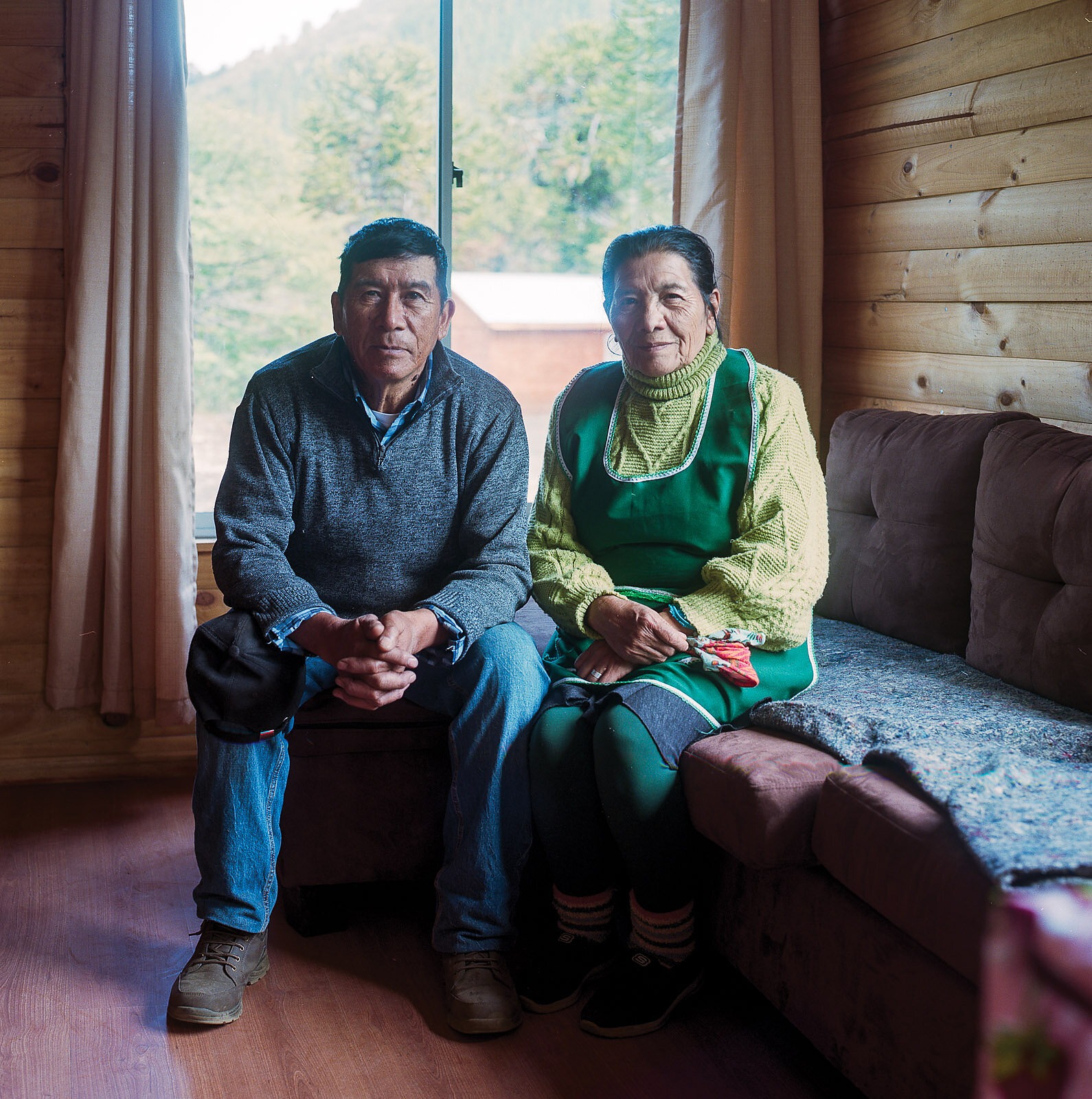
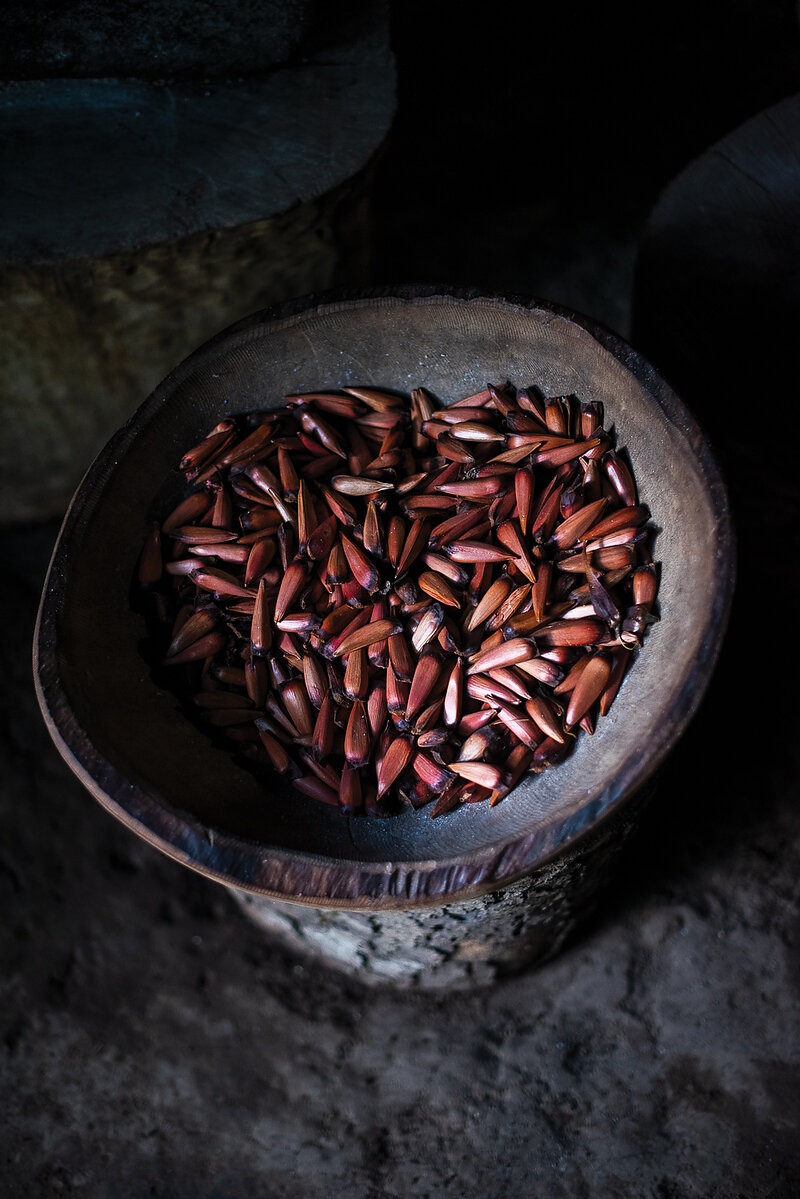
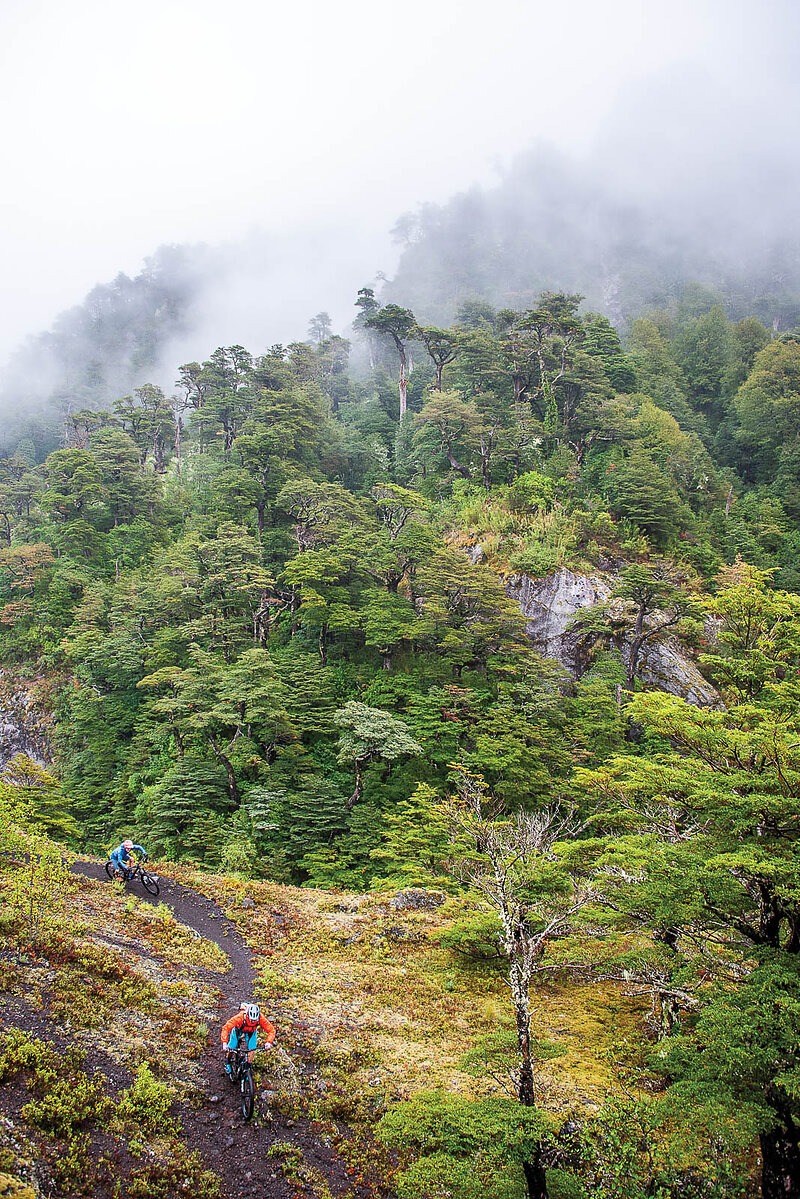
A few minutes later, we roll into an idyllic farm alongside the sparkling Cautín River. A gaucho (cowboy) in sheepskin chaps leads his horse to a stable. An elderly woman emerges from a smoky doorway and gives Araneda a big embrace. Though Chile is a vast country, so far it seems like our guide knows everyone.
Roza Namco Rozar is the matriarch of a cooperative of families that has added mountain bike tourism to its cattle-raising income. This pragmatic approach to change is what our Chilean friend Cristian Levy—an adventure-travel entrepreneur who had generously helped to facilitate our trip to the country—has described as the “practical” nature of the Mapuche people. Though they hold fast to many of their traditions, they’re also increasingly willing to share ancestral land with visitors in a way that sustainably augments their income.
The table is set for lunch, and bowls of cazuela— a hearty soup of chicken, potatoes, and squash—appear along with side dishes of delicious Chilean salsa. As soon as we drop spoons into empty bowls, Rozar returns with refills and then sits with Araneda to reminisce about the Lonquimay eruption of years ago.
Medig and I sip a milky digestif made of fermented piñones, and two hours later, we waddle back out to the pasture to find our bikes. We’d been weighing up the possibility of an adventure ride from the barren wastes of Lonquimay's Christmas Crater all the way back down to the lush green of this river valley. Wiggly lines along the valley floor, visible with the naked eye, suggested a rideable route. Araneda plies the gaucho for information about trails higher up.
“Si, se puede. Pero, hay pumas,” the gaucho affirms, mentioning the presence of mountain lions as an afterthought.
A plan is hatched, and the next morning, a shuttle transports us beyond the monkey puzzle trees into a stark world. Tufts of golden grass poke stubbornly from an otherwise monochromatic landscape of black ash. Off-road vehicles have worn in a doubletrack to the flat-topped summit above the Cautín River. The climb to the top is steep and loose, but Araneda cleans it without a dab.
The descent feels more like skiing than mountain biking, with use of our front brakes not a viable option. Once we reach the tree line we set out on a horse trail that winds through old-growth monkey puzzle trees before plunging into dense thickets of leg-scratching bamboo alongside the Cautín River. A puma would find easy cover here, and I let my imagination get the best of me. But other than a few blackbirds, there are no signs of wildlife. Two hours later, we rolled through the farm where we’d had lunch the day before. The place is deserted. It must be a town day for our friendly hosts.
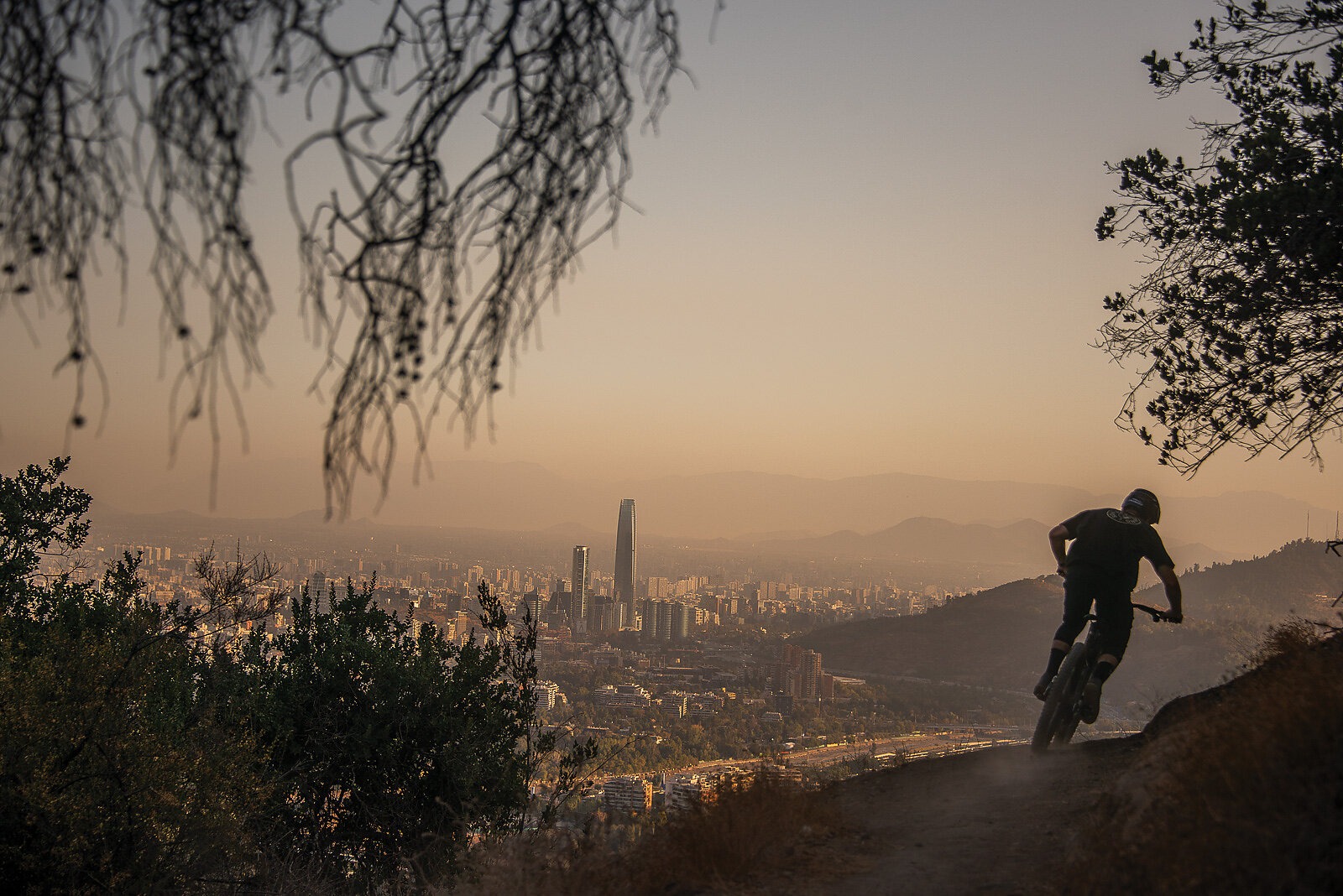
After a week of exploring this unique mountain biking frontier and the informal tourism partnerships with the proud Pehuenche people, we were left wondering about the genesis of mountain biking in Chile. To find it, Araneda told us we’d need to venture north, to the glittering capital city of Santiago and the many trails that weave through the surrounding Andean foothills. On these slopes that hem in a metropolis of 8 million residents is where mountain biking got its start in Chile. Naturally curious, Medig and I hopped on a plane and flew to Santiago.
On another sunny fall afternoon, Juan Sebastian Garrido pedals up an access road winding to the top of Santiago Metropolitan Park. The blue sky is stained with city smog. To the west of this hilly park is the hardscrabble, working-class neighborhood known as the Barrio El Salto, while to the east are the affluent streets and posh boutiques of the Barrio Los Descubridores. In between these contrasting neighborhoods is a fascinating mountain bike trail network that is unique for a city of this size. In years past, the park was a no-go area filled with armed thieves and a few rogue trails scratched in by a handful of brave souls. Today, it’s a fully legitimate mountain biking playground.
After 20 minutes of climbing on asphalt, Garrido branches onto a steep dirt track that angles crudely upwards. The trail follows a ridge crest up and down, then ascends again to an amphitheater named after the late poet and activist Pablo Neruda, a socialist foe of the late Chilean dictator Augusto Pinochet.
“My twin brother and I watched ‘New World Disorder,’ then came up here with some bikes and rode Torre 5,” Garrido says, referring to one of the original trails built when mountain biking still wasn’t allowed in the park. “We didn’t even have helmets. We didn’t know anything.”
Today, Garrido knows a lot. The young man has turned his passion for mountain biking into a lifestyle. He owns and runs a coaching company named AMBA and co-hosts a popular podcast about all things Chilean cycling.
At the top of another road climb we reach the park’s high point, where a gondola deposits tourists seeking sweeping views of the sprawling cityscape. Garrido points his wheel downward and launches into 4 ½, a techy test section that drops roughly 600 vertical feet from near the gondola station.
“Beware of the ‘anti-grip,’” Garrido warns, referring to the slippery, ball-bearing trail surface typical of Santiago’s arid surrounding hills. He then proceeds to slay the trail’s big technical gaps and doubles, made all the spicier by the “anti-grip” transitions.


At the end of the descent, Garrido leaves us in the capable hands of Jona Jünge, the Brazil-born marketing manager for Specialized Bicycles in Chile. Jünge has seized the opportunity to leave the office early and show a couple of gringos another Santiago’s mountain biking heritage.
A 20-minute van ride through Santiago’s confusing maze of tunnels and freeways takes us to the upscale neighborhood of Lo Curro, where mansions protected by iron gates line a hillside overlooking the Mapocho River. This is where ambassadors and billionaires live. It’s also the problematic access route to a stunning network of gravity-oriented trails.
“To get to these trails you have to cross private land, and the landowner is trying to stop it,” Jünge says. “So, we have illegal access to legal trails.”
As we soon discover on the climb up, mountain bikers and hikers are universally ignoring the “Private Property, No Trespassing” signs. Jünge scoots ahead on his eMTB, a popular choice around here, while we granny gear stoically on our pedal bikes. The incessant white noise of the city hums below. A huge, hairy tarantula crosses the trail then disappears behind the trunk of a tall cactus.
Jünge belongs to a WhatsApp group of mountain bikers known as Syndatico Pink Floyd. They advocate with the landowner, organize trail-maintenance days, and raise funds to hire crews to build new trails. After long, hot summers, these Andean trails become exceptionally dry, requiring substantial repair work.
We pause for a water break at the top of a recently built trail called “Classico Egipcios,” funded by an anonymous donor. “Because they worked like Egyptians to build it,” Jünge explains.
The glow of early evening gilds the glass towers of Santiago. The city looks beautiful, almost ethereal. It’s worlds away from the rural land of lakes and volcanos where we’d started our journey, but no less impressive.
“After you guys,” Jünge says. “Just follow it all the way down. No surprises.”
But in the unfamiliar, there are always surprises. We charge down the trail, snaking a narrow ridgeline through thick brush, with steep, fall-away corners and rock drops, chasing the day’s last light to the glimmering city below.
